“Little İstanbul” Population: 23,000
Old name: Nicaea
İznik is the town that has it all – a stunning lakeside location, ancient city walls that resemble a cut-down version of İstanbul’s, the remains of a Byzantine church with a venerable history and a tile-making tradition that dates right back to the Middle Ages. It’s a town that should be mobbed by tourists, so it’s a pleasant surprise to discover that unless you visit on a weekend during the school holidays you are unlikely to be trampled in the rush. The reason, of course, is that the lake (the old Lake Askania) can’t compensate for the distance from the sea.
For city-lovers, its bigger neighbour Bursa also wins out because it has the shopping and nightlife to go with the monuments. Still, if you’re the sort of person who likes to feel that they’re one step ahead of the crowd, İznik could be just the place for you.
İznik is a great place in which to mooch about, with wide, tree-lined streets and lots of minor historic monuments tucked down the back streets. The growing interest in all things ceramic means that there are also lots of pottery shops to visit, including a showroom set up inside what was once the women’s part of the 15th-century II. Murad Hamam.
Because the lake is outside the city walls, it’s surprisingly easy to overlook, especially if you only come for a day trip and have your eye on the time of transport back to İstanbul. But it would be a great shame not to stroll down to the waterside and settle down for a light lunch or a tea in one of the many tiny cafes that open their doors here in summer.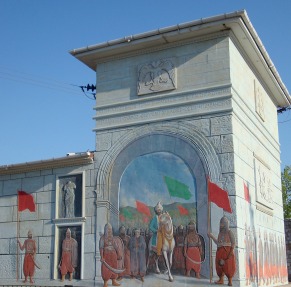
In 2024 a newly excavated Roman theatre was opened to the public, south-west of the town centre. It dates from the reign of the Emperor Trajan (r.98-117).
Backstory
It sometimes seems as if there isn’t a single town in Turkey that has not at one time or another laid claim to being a capital city, but that honour has fallen to İznik twice, the first time way back in history when it was the capital of the small kingdom of Bithynia, founded by one of Alexander the Great’s generals in 316 B.C.
The second time it made a grab for glory was when it found itself unexpectedly caught up in the aftermath of the extraordinary Fourth Crusade, a particularly inglorious chapter in the history of the Crusades that took place in 1204, when the Christian forces supposedly heading for Egypt let themselves get side-tracked into attacking Constantinople (İstanbul). As a result of their actions, Byzantine Emperor Alexios V Ducas was forced to flee.
Some of the court fled east and set up the Kingdom of Trabzon on the Black Sea. Alexios’ successor, Theodoros I Lascaris, decided to hang on closer to home in İznik where he set up the so-called Nicaean Empire. He died there in 1222, but the fifth Nicaean monarch Michael VIII Paleologos managed to regain Constantinople in 1261 (in contrast the remote Kingdom of Trabzon held out until the Ottoman conquest in 1461).
The end of the People’s Crusade. In 1096 at Civitot (Drakon) near İznik the Selçuk forces under the leadership of Kılıç Arslan defeated the forces of the so-called People’s Crusade under Peter the Hermit and Walter Sansavoir. Walter died in the fighting although Peter survived because he was in Constantinople negotiating with Alexios Comenenos. Around 17,000 people are believed to have died. Shortly afterwards Kılıç Arslan opted not to try and raise the siege laid to Nicaea by the forces of the main First Crusade. He rode away, leaving the city to its fate, and Alexios than managed to regain it for the Byzantines through subterfuge.
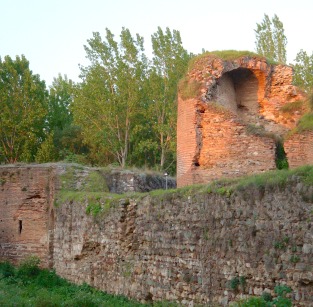 Stretch of wall near the İstanbul GateAround town
Stretch of wall near the İstanbul GateAround town
Unfortunately there’s not much left to show for either of these periods of glory. Instead it’s the long period of Roman supremacy which segued neatly into Byzantine government that stamped its mark most firmly on what was then Nicaea. The most conspicuous survivors from this period are the walls, towers and gates that still ring the city centre. Apparently there were once a grand total of 200 towers although most are gone now.
Although some of the gates have been widened to permit traffic access, the walls are still virtually intact, and it’s fun to walk around them, imagining how the town would have looked in the days when they were used by horses and carts rather than cars.
The other major monument to the Byzantines is the Church of Hagia Sophia (Ayasofya) that squats in a sunken rose garden, its architecture a mish-mash of styles cobbled together as first earthquake, then fire wrote off two previous incarnations. That prolific builder, the Byzantine emperor Justinian, had a new church built on the site of Constantine the Great’s church where the First Ecumenical Council had met to draw up the Nicene Creed, which sets out the basic tenets of Christianity, in 325. It was in the post-earthquake incarnation that the coronations of the Nicene Emperors were held. The church was restored to serve as a mosque in 2011.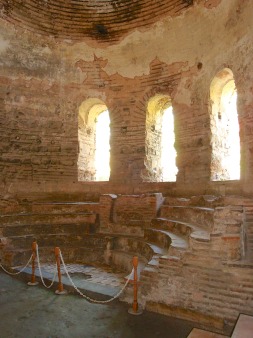 Interior of restored Hagia Sophia
Interior of restored Hagia Sophia
Not far from the remains of Hagia Sophia are fairly uninspiring ruins, the Çini Fırınları (Tile Kilns), that are, nevertheless, a reminder of İznik’s main claim to fame as the centre of Turkey’s historic tile-making industry.
A few finds from the excavated kilns are displayed in the İznik Kültür Müzesi (closed Mondays), which is housed inside a graceful imaret (soup kitchen) set up by Sultan Murad I in 1388 in memory of his mother. This is just down the road from the 14th-century Yeşil Cami (Green Mosque) whose minaret boasts some exquisite turquoise tiles from an earlier era.
To inspect a better selection of İznikware you should head towards the old Saray Kapısı (Palace Gate) near the lake (the old Lake Ascanius). Just inside the walls stand the headquarters of the İznik Vakfı, a charity which was instrumental in reviving interest in a lost art. If not too many professional tile experts are in residence you may even be able to bed down for the night in its delightful guesthouse.
İznik tiles Tiles were already being made here before 1514 but in that year Sultan Selim I resettled tile-makers from Tabriz in Persia (Iran) in town; it may have been the newcomers who taught the local craftsmen how to create the famous tomato-red glaze that was to become the signature of an İznik tile.
Sixteenth century İznik tiles are regarded as some of the finest ever made and wonderful examples are on display in the Çinili Köşk (Tiled Pavilion) inside İstanbul‘s Archaeology Museum. It was also İznik tiles that bestowed on Sultanahmet Cami its nickname, the Blue Mosque, which is somewhat ironic given that it was actually the splashes of bright red colour that made the tiles so special, enabling the ceramicists to create the tulip and carnation designs that are such a hallmark of Ottoman art.
The story of the Blue Mosque is a cautionary one that reveals how easily something can be destroyed by its own popularity. Determined to see the walls of his new mosque tiled to the highest standards, Sultan Ahmed I conscripted all the İznik tile-makers to work on the task, forbidding them to do anything else in the meantime. Unfortunately he scrimped on paying the artisans and many of them sneaked away to set up new businesses in Kütahya. Work on the Blue Mosque took seven years to complete. At the start of the project records suggest that there had been about 300 kilns in İznik. By its end there were a paltry nine.
Worth reading: A Self-Guide to İznik Tiles in İstanbul by Edda Renker Weissenbacher.
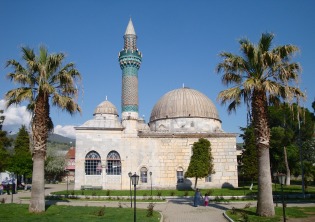 Yeşil Cami, İznikSleeping
Yeşil Cami, İznikSleeping
İznik Vakfı Konukevi
Tel: 0224-757 6025
Çamlık Motel
Right beside the water and with its own restaurant, the Çamlık makes the perfect place to soak up the view as the sun sets over the lake. Rooms are rather faded though and the restaurant seems past its prime. Tel: 0224-757 1631
Kaynarca Pansiyon Tel: 0224-757 1753
Grand Hotel Belekoma Tel: 0224-757 1407
Travel info
To get to İznik from İstanbul take the İDO fast ferry from Yenikapı to Yalova, then pick up a bus immediately opposite the terminal. Tel: 444 4436, www.ido.com.tr.
There are hourly dolmuşes to Iznik from Bursa; they leave from the side of the main otogar and take the pretty road along the south side of İznik Gölü (Lake İznik).
Day trip destinations
Read about my visit to Hagia Sophia after it became a mosque again: http://www.turkeyfromtheinside.com/blogbloggingaboutturkey/entry/53-a-mosque-too-far.html
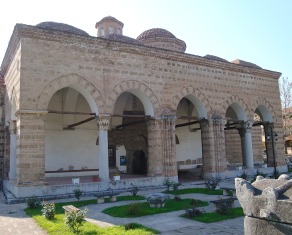 Iznik Museum
Iznik Museum
İznik in İstanbul There’s no need to trek all the way to İznik to appreciate its famous tiles – there are thousands of excellent examples in İstanbul. Get your eye in at:
Blue Mosque
Aya Sofya
Topkapı Sarayı Harem
Çinili Köşk (Archaeological Museum)
Rüstem Paşa Cami
Şehzade Cami
Süleymaniye Cami
Sokollu Mehmet Paşa Cami
Kiliç Ali Paşa Cami
Fatih Sultan Mehmet Cami
Çinili Hamam, Üsküdar
Eyüp Mausoleum
Where to buy İznik tiles: İznik Vakfı: Tel:0212-287 3243


